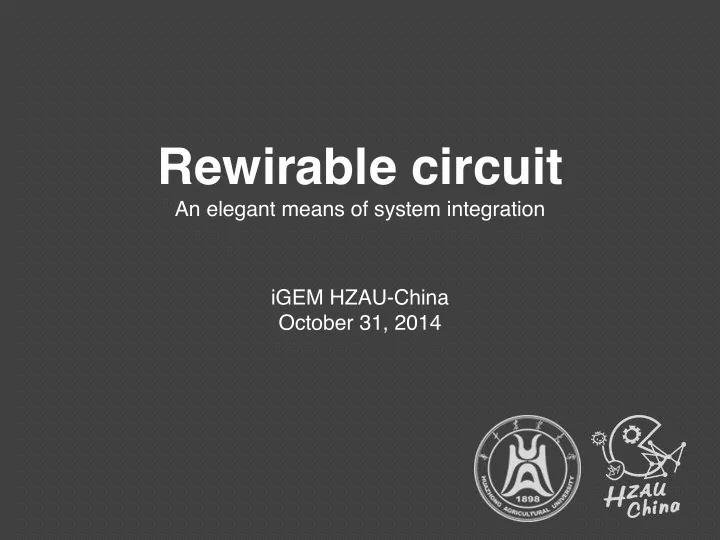

Rewirable circuit An elegant means of system integration iGEM HZAU-China � October 31, 2014
Background Synthetic systems vs Natural systems Synthetic biological system Natural biological system T T T T T Small modules Overlapping module T T T Duplicated the existing parts Logic elements T T Standard parts Disordered parts
Background Adaptability—what synthetic biological systems lack One module, one function. How to process different information with one module?
Background Intuitive solution: Combining circuits As the complexity increases • Crosstalk • Host overload
Our approach Our Solution: The rewirable circuit What if we can alter regulatory pathways and reuse existing parts? Rewirable circuit
Our approach Advantages More adaptive with fewer parts used. � Less is more! • Choosing specific processing modules when needed • Reducing workload • Eliminating crosstalk between processing modules.
Information processing Viability of our design T T T T cI tetR lacI cI lacI T Repressilator Toggle switch lox71 lox66 T T cI tetR lacI T Our rewirable circuit
Information processing Viability of our design lox71 lox66 T T lacI cI tetR T Our rewirable circuit Our Biobricks: BBa_K1368000 � BBa_K1368002
Information processing Preliminary works Parameter Value β 0 0.03 K dp 0.0069 K dm 0.347 K tl 6.93 ··· ··· Data collection Characterization d [ B mRNA ] K n K n + A n − K dm [ B mRNA ] = β 0 + β dt d [ B ] = K tl [ B mRNA ] − K dp [ B ] dt Modeling
Information processing Parameter scanning and dynamic analysis Limit cycle attractor Strength of promoter C Fixed point attractor An attracting limit cycle A Strength of promoter B emerges as the promoter r e t o m o r p f o h strength increases. t g n e r t S
Information processing Preconditions to implement both oscillation and bistability • To implement oscillation The weakest promoter must be strong enough. • To implement bistability Two promoters’ strength must be approximately equal.
Information processing Simulation results
Information processing Another rewirable circuit design T T luxR aiiA luxI T luxpR luxpL luxpR luxpL AHL Our Biobricks: BBa_K1368004 � BBa_K1368005 � BBa_K1368006
Information processing Results from fluorescence microscope LuxR-‑AHL ¡complex LuxR-‑AHL ¡complex T GFP luxpR LuxI LuxI AiiA AiiA Positive feedback stage Negative feedback stage
Information processing Results from multifunctional Results:experimental results were microplate reader consistent with our expectations
Information processing Design procedures Matrix Topology • Design fitness functions A A B C A 0 0 − 1 B − 1 0 0 • Scan the topological space C B 0 − 1 0 C • Match topological structures Fitness A =0.7891 Fitness B =0.8915 • Sort and select … More details can be found in our modeling part
Information processing Potential applications • Circuit design in synthetic biology • Living therapeutics • Environment improvement • …
Information processing Potential applications • Circuit design in synthetic biology Plenty of time for comparison Leave it to nature • Living therapeutics • Environment improvement • …
Information processing Potential applications • Circuit design in synthetic biology • Living therapeutics • Environment improvement Maintain homeostasis Make next decision • …
Information processing Potential applications • Circuit design in synthetic biology • Living therapeutics • Environment improvement Function � proteins Pollution • … Negative feedback: � Positive feedback: � maintain the lower steady state increase efficiency
Information processing Potential applications • Circuit design in synthetic biology • Living therapeutics • Environment improvement • …
Improvements in I/O modules Lower the leakage of recombinase Problem: leakage Solution: riboregulator T cre T cre Input taRNA Our Biobricks: BBa_K1368007 � BBa_K1368009 � BBa_K1368013 � BBa_K1368015 cre
Improvements in I/O modules Riboregulator assay Positive control Negative control 1 � 71 Experimental group 1.9 Fold 2.5 Fold 5.5 Fold
Improvements in I/O modules Increase response rates in output module + Fluorescent protein RNA aptamer Fluorophore
Improvements in I/O modules RNA level fluorescence DMHBI + � DMHBI + � DMHBI 13-2 RNA control RNA Population level Single cell level Our Biobricks: BBa_K1368010 � BBa_K1368011
Highlights Elegant design • Carefully arranging the order of parts • Reusing the existing parts and pathways
Highlights Balance of biology and engineering Biological modules: Engineering modules: overlapping and closely related independent Module B Module A Module A Module C Module B Module C
Highlights Balance of biology and engineering • Simplified Module B like the biological modules Module A Module C • Independent time like the engineering modules
Highlights Synthetic biological system with rewirable circuits is like Transformer!
Policy & Practices Giving circuit adaptability is like giving it intelligence . What if it suddenly begins making variations of its own? —Other implications of the Rewirable Circuits
Policy & Practices Whose Intellectual Property Right? • Circuit user • Circuit designer • …Nobody?
Policy & Practices A model providing stimulus for thinking A 4-Dimensional model to help iGEMers think : Awareness Positive Stage Negative Negative Positive 2nd-dimension 3rd-dimension 4th-dimension
Policy & Practices Outreach
Achievements • We proposed a concept of rewirable circuit which can process different information with one module. • Our input module, processing module and output module worked as we expected. • We documented and submitted 13 new standard parts. • Our team and HUST-China helped each other in lab work. • We improved the characterization of 3 existing BioBrick Parts. • We held a meetup this August in which 15 teams took part.
Acknowledgement Sponsors and departments: Instructors: Advisors:
Acknowledgement Our Team!
Thanks
Recommend
More recommend